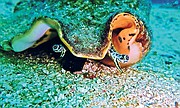By MORGAN ADDERLEY
Tribune Staff Reporter
madderley@tribunemedia.net
A NEW study has confirmed that marine protected areas such as the Exuma Cays Land and Sea Park can help save the Bahamas’ queen conch stocks, as they help replenish nearby populations.
The study calls for the creation of a “network of MPAs” that will facilitate the exchange of queen conch larvae “for a sustainable future”.
It also suggests locations for future MPAs, such as between the ECLSP and Great Guana Cay, Abaco.
The study, “Ecological spillover from a marine protected area replenishes an over-exploited population across an island chain”, was published by the Chicago-based Shedd Aquarium last month.
The findings were revealed in a press release issued on Monday.
Shedd Aquarium was the same group which found in October 2018 that the Bahamas’ queen conch supply could be wiped out in 10-15 years unless significant measures are taken to cut fishing pressure.
“After a 2018 review of queen conch populations in the Bahamas indicated rapid declines, a new research study brings hope for how to save the imperiled marine snail’s future,” Monday’s press release noted.
“The study…shows that conch within a well-enforced marine protected area (MPA), an area where fishing is banned, reproduced and replenished populations of queen conch within fishing grounds.
“The results highlight the importance of MPAs beyond their borders, and the study suggests where to expand a network of protected areas within the Bahamas to benefit queen conch populations across the island nation.”
Shedd Aquarium research biologist and and the study’s lead author Dr Andy Kough notes the research “unequivocally demonstrated that conch protected within a no-take park replenished nearby populations as they reproduced and their babies, called veliger larvae, spilled over into non-protected areas.”
“If some areas where adults are abundant enough to breed are protected, they can help ensure a healthy environment and thriving fishery with conch for years to come,” Dr Kough said.
To confirm these findings, the research team studied both adults and larvae by using SCUBA surveys to collect information on the age, size, and abundance of adult conch and a computer programme to estimate where larvae are dispersed, according to the press release.
One study area was the ECLSP, and there were three key research findings: there are three times as many adult conch within the MPA; effective MPA enforcement by Bahamian officials resulted in conch that were bigger and older; and larvae that originated from the MPA settled in unprotected areas outside of its borders, including fished sites with densities currently too low for reproduction.
The study added the Bahamas National Trust conducted surveys of fisher’s opinions on the issue of queen conch population.
BNT marine science officer and study co-author Agnes Lundy said during their conversations with fishers and communities, it was acknowledged that conchs are getting harder to find and that people want to help them rebound.
“Based on the noted success of the Exuma Cays Land and Sea Park and the desire of Bahamians to help conch bounce back, the study suggests locations for future MPAs, such as between the Exuma Cays Land and Sea Park and Great Guana Cay,” the press release continues.
“The suggested locations were determined using the open-source Connectivity Modeling System of the Rosenstiel School of Marine and Atmospheric Science (RSMAS), a tool that estimates the long-distance travel of conch larvae and how marine ecosystems are connected to one another.
“The new additions would establish a network of MPAs within Bahamian waters.”





Comments
juju 5 years ago
THEY need to stop the dredgers of the conch breeding spits in North Abaco as a first step. Find them other locations to mine sand. BNT and Friends of the Environment turn a blind eye to this. No one wants to deal with local businesses. Who is going to step up? This is lomg overdue in Abaco.
Sign in to comment
Or login with:
OpenID